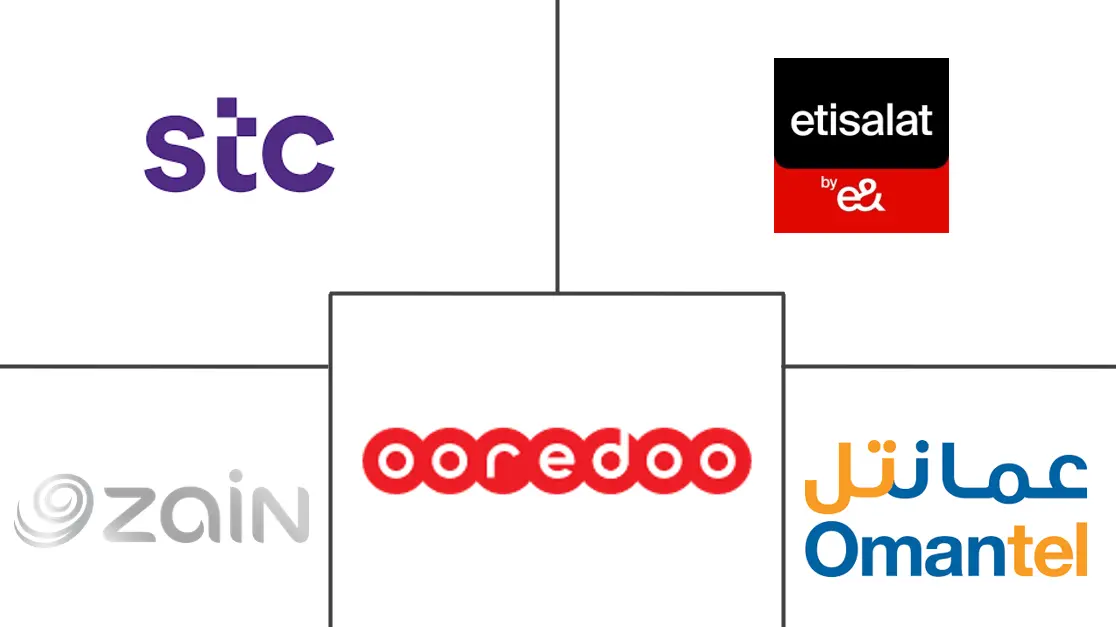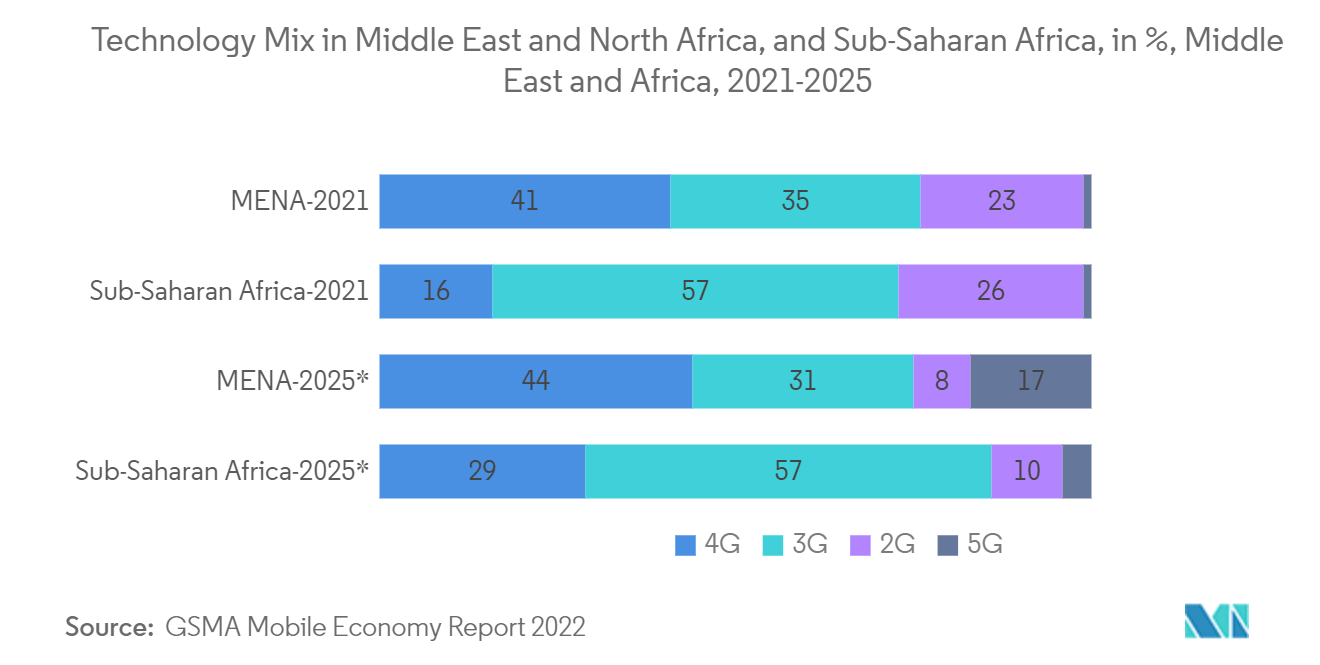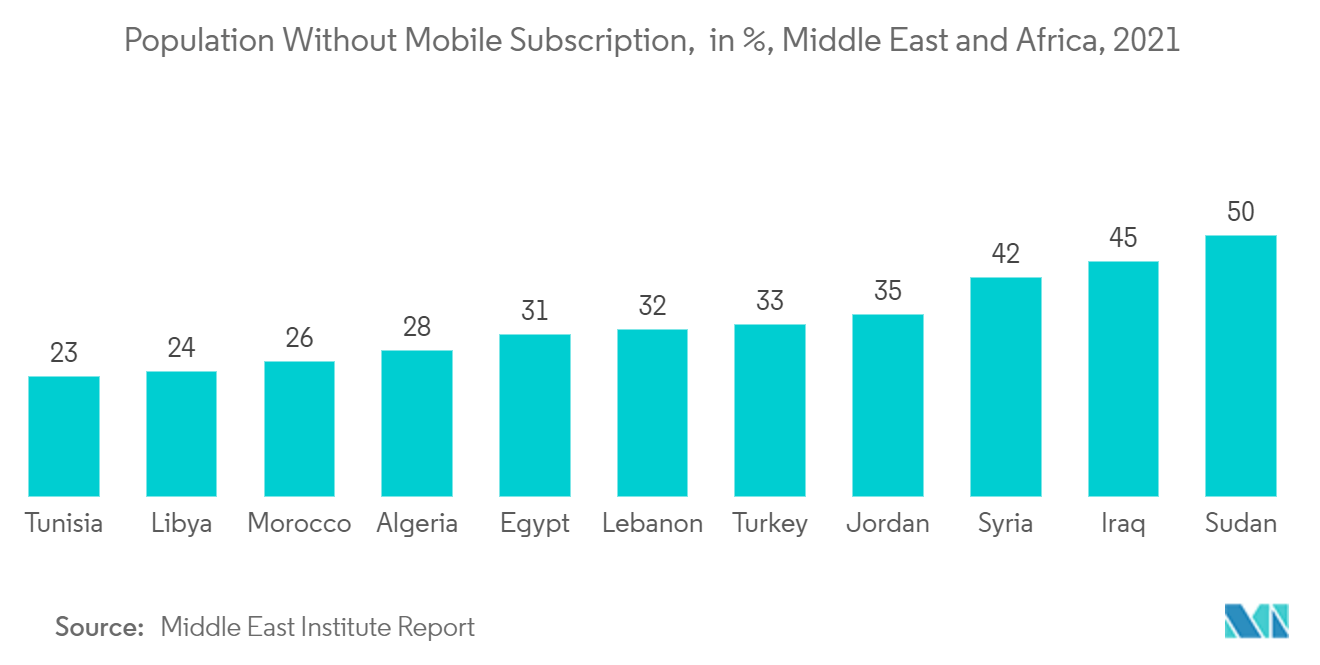MEA Telecom Market Size

| Study Period | 2019 - 2029 |
| Base Year For Estimation | 2023 |
| Forecast Data Period | 2024 - 2029 |
| Historical Data Period | 2019 - 2022 |
| CAGR | 5.28 % |
| Market Concentration | Medium |
Major Players
*Disclaimer: Major Players sorted in no particular order |
MEA Telecom Market Analysis
The Middle East and Africa telecom market is anticipated to expand at a CAGR of 5.28% during the forecast period. The use of telecom services like Saudi Telecom Company, Etisalat Group, Ooredoo Group, Zain Group, Oman Telecommunications Company, etc., by businesses and services nationwide is progressing quickly.
- The previous 25 years have seen a revolution in telecommunications, from the Middle East has benefitted from active participation. With the exception of Lebanon, Syria, and a few other nations whose reforms were only cosmetic, the majority of the countries in the region have liberalized their telecom businesses since 2000 and put them on a path of steady, dynamic growth. Even though some states hold substantial telecom shares, they have increased competition, set up efficient regulatory bodies, and moved investment to the private sector.
- The Middle East is not an exception to the fact that mobile communications are the technology that has spread the quickest in historical records. According to GSMA reports, It has 400 million unique mobile users after 25 years, of whom 280 million started using mobile internet. The mobile ecosystem generated almost 640,000 indirect employment within the same period and 360,000 direct ones in the area.
- The main factors driving market growth in the region are the establishment of Mobile Virtual Network Operators (MVNO), the expansion of fiber-based networks and fixed broadband services, and the achievement of telecom sector liberalization.
- The market challenges are expected to have an impact on telecom service expenditure due to widespread job losses and the resulting reduction in disposable incomes. For instance, on May 2022, as per World Bank Report, the average rate of employment growth in the private sector in MENA nations was one percent per year, which is much less than the five percent average among middle-income peers. In addition to the high young unemployment rate, which is projected to be 26 percent, female labor force participation, at 20 percent, is the lowest in the world.
- The Middle East's telecom sector has changed significantly over the past few years due to several phenomena. One of them is COVID epidemic of the past two years did not considerably affect telecom revenues (a decrease of less than 1 percent). Still, it highlighted the telecom networks' robustness and adaptability as they managed to withstand the unexpected spike in usage.
MEA Telecom Market Trends
This section covers the major market trends shaping the MEA Telecom Market according to our research experts:
5G technology is Expected to have Significant Share
- Governments and authorities in GCC nations, including Bahrain, Kuwait, Oman, Qatar, Saudi Arabia, and the UAE, have granted spectrum, and mobile carriers have deployed some of the first 5G networks in the world, making them 5G pioneers in the MENA area.
- However, a significant number of nations (Algeria, Egypt, Jordan, Lebanon, Morocco, Tunisia, and Turkey) have begun to identify the appropriate 5G spectrum and the best strategies for clearing the spectrum, which will feed into any technical limits and related technical license requirements. It is projected that 5G networks and services will be accessible in these nations starting in 2023.
- It is reported that operators have been testing and evaluating 5G in Algeria, Egypt, Morocco, and Turkey, and at least one operator has been developing a 5G network in Lebanon. In November 2021, Total Telecom reported that using Fixed Wireless Access (FWA), the Middle East region has taken the lead in bringing high-speed 5G connection to more people. There are over a million 5G FWA customers in the Middle East and Africa (MEA) area.
- The COVID-19 outbreak has delayed some of these countries' plans to roll out 5G. According to the GSMA's most recent projections, these nations should deploy commercial 5G services (BWA and mobile) between 2022 and 2024.
- According to GSMA Mobile Economy 2022 report, 5G technology is estimated to account for 17% of the total technology mix by 2025 in the Middle East and North Africa (MENA) region. In Sub-Saharan Africa, 5G to reach 4% by 2025.

Challenges in the Region Restrain the growth
- Data privacy and cybersecurity are two new regulatory problems that have emerged. These challenges have become serious as more and more users' private data is made available to telecom providers, social media platforms, and many other organizations. The region's nations were inspired to recognize the value of data protection by implementing the EU's General Data Protection Regulation (GDPR).
- Legislation has been proposed in an effort to advance data privacy while supporting the expansion of the digital economy. Others have dealt with it using a top-down strategy primarily concerned with strengthening state control, which might dash the nation's hopes for a quick digital transformation of its government and industry institutions.
- However, the Levant, North Africa, and Iran are subject to a sizable population of disconnected individuals, with 140 million not using mobile services and 350 million not using mobile internet. To close this gap, tens of millions of people will have to overcome the cost barrier or fight illiteracy.
- The direction of regional telecommunications trends is correct. However, not enough is being done to make mobile broadband and services available to more people. Most nations' universal service funds have been generating wealth from operators that might have been used to expand coverage in places where it is not economically feasible.
- Most governments have not provided adequate funding for digital government services or have not coordinated their policy in this regard. The majority of other countries haven't done much on this front. Still, the UAE and Saudi Arabia have prioritized having an environment that draws digital enterprises and allows them to develop quickly.

MEA Telecom Industry Overview
The Middle East and Africa telecom market is moderately consolidated and consists of several major players. The major players with a prominent share in the market, such as Saudi Telecom Company, Etisalat Group, Ooredoo Group, Zain Group, Oman Telecommunications Company, etc., are focusing on expanding their customer base across foreign countries through the adoption of various technologies.
- November 2021 - According to a company official, Saudi Telecom Co., the prominent telecoms firm in the Middle East, would invest SAR1.5 billion (USD 400 million) to establish the largest cloud-enabled data center in the area as the oil-rich nation strives to become a hub for digitalization.
MEA Telecom Market Leaders
-
Saudi Telecom Company
-
Etisalat Group
-
Ooredoo Group
-
Zain Group
-
Oman Telecommunications Company
*Disclaimer: Major Players sorted in no particular order

MEA Telecom Market News
- June 2022 - To support its vision of providing cutting-edge, data-driven digital services to enterprise and government customers throughout the Middle East and North Africa (MENA), ZainTech, the ICT solutions and digital powerhouse of the Zain Group, has announced a partnership with data analytics specialist, LigaData. The strategic cooperation between ZainTech and LigaData highlights ZainTech's dedication to utilizing data's potential to create cutting-edge digital solutions for its corporate and government clients and the larger Zain Group.
- March 2022 - A collaboration deal between Ericsson and Saudi Telecom Company (stc) has been linked to advance 5G connectivity in Saudi Arabia. According to the agreement, STC and Ericsson will explore the technological potential of 5G network slicing and long-range mmWave for STC to increase the performance and coverage of their 5G network.
- March 2022 - Ooredoo Group announced the choice of SAP as its partner to allow a full digital business transformation and consolidation of all its Enterprise Resource Planning (ERP) systems across most of its ten operating entities. Through integrated and end-to-end processes and systems, as well as more automation and optimization, the cooperation will make sure Ooredoo has the right infrastructure to improve the experience of its customers, workers, and suppliers.
MEA Telecom Market Report - Table of Contents
1. INTRODUCTION
- 1.1 Study Assumptions and Market Definition
- 1.2 Scope of the Study
2. RESEARCH METHODOLOGY
3. EXECUTIVE SUMMARY
4. MARKET INSIGHTS
- 4.1 Market Overview
-
4.2 Industry Attractiveness - Porter's Five Forces Analysis
- 4.2.1 Bargaining Power of Suppliers
- 4.2.2 Bargaining Power of Consumers
- 4.2.3 Threat of New Entrants
- 4.2.4 Threat of Substitute Products
- 4.2.5 Intensity of Competitive Rivalry
5. MARKET DYNAMICS
- 5.1 Introduction to Market Dynamics
-
5.2 Market Drivers
- 5.2.1 Increasing Development of Fiber-based Networks and Fixed Broadband Service
- 5.2.2 Successful Liberalization of Telecom Sector & Launch of MVNOs
-
5.3 Market Challenges
- 5.3.1 Telecom Service Spending to be Impacted by Large-scale Job losses and the Consequent Restriction in Disposable Incomes
6. SMART MOBILITY DEVELOPMENTS IN MEA
- 6.1 Smart Mobility Ecosystem
- 6.2 Urbanization Status in GCC Countries (Metrics on population, car accidents, leading smart cities (Doha, Abu Dhabi, Dubai, Riyadh)
- 6.3 Automated Transport Opportunities (Coverage on developments such as smart pods, hyperloop, autonomous vehicles, delivery drones, skyway, flying taxi)
- 6.4 IoT and Connectivity (IoT overview, inter vehicle connection, Mobility as a Service, IoT and conncetivity projects in GCC, etc.)
- 6.5 Key Urban Planning, Transport, And Infrastructure Projects (Coverage on UAE (Abu Dhabi metro and light rail project, Dubai metro expansion, etc.), KSA (Riyadh metro, Landbridge, KSA national rail network), and others)
7. TELECOM INDUSTRY DEVELOPMENTS VIS-À-VIS SMART CITIES IN MEA
- 7.1 Telecom Infrastrucutre Development in Smart Cities (Digital transformation initiatives among telecom companies, coverage on Dubai, Abu Dhabi, KSA, strategic developments by telecom companies (Etisalat, du, etc.))
- 7.2 Middle East IoT Projects vis-à-vis Smart Cities Developments (Impact on utility industry, security, and business ecosystem including regulatory policies and challenges)
- 7.3 5G Adoption in MEA and Impact on Smart Cities (Overview, high tech hubs on 5G technology, smart transportation, etc.)
- 7.4 Key Metrics on Telecom (Technology mix (2G/3G/4G/5G), mobile and internet penetration, APRU)
- 7.5 Connectivity Landscape (Company growth, recent developments - technology & regulatory with respect ti Etisalat, Ooredoo, STC, Turkcell, Zain, etc)
- 7.6 Growth Opportunities in Telecom Sector (Open RAN, Edge computing)
8. TELECOM MARKET SEGMENTATION
-
8.1 By Type
- 8.1.1 Mobile
- 8.1.2 Fixed Line
- 8.1.3 Broadband
-
8.2 By Geography
- 8.2.1 UAE
- 8.2.1.1 By Type
- 8.2.2 Saudi Arabia (KSA)
- 8.2.2.1 By Type
- 8.2.3 Rest of MEA ( Algeria, Bahrain, Egypt, Iran, Iraq, Israel, Jordan, Kuwait, Lebanon, Libya, Morocco, Oman, Qatar, Syria, Tunisia, and Yemen)
9. COMPETITIVE LANDSCAPE
-
9.1 Company Profiles
- 9.1.1 Saudi Telecom Company
- 9.1.2 Etisalat Group
- 9.1.3 Ooredoo Group
- 9.1.4 Zain Group
- 9.1.5 Oman Telecommunications Company
- 9.1.6 Telecom Egypt
- 9.1.7 Mobily
- *List Not Exhaustive
10. INVESTMENT ANALYSIS
11. FUTURE OF THE MARKET
** Subject To AvailablityMEA Telecom Industry Segmentation
The study tracks the telecom industry in the Middle East, with detailed coverage of the underlying market trends, subscriber base, revenues, and vendor operations. The major segments covered in the study include fixed-line services, mobile services, broadband services, and upcoming areas such as IoT & M2M in the region.
The Middle East and Africa telecom market is segmented by type (Mobile, Fixed Line, and Broadband) and by geography.
| By Type | Mobile | |
| Fixed Line | ||
| Broadband | ||
| By Geography | UAE | By Type |
| By Geography | Saudi Arabia (KSA) | By Type |
| By Geography | Rest of MEA ( Algeria, Bahrain, Egypt, Iran, Iraq, Israel, Jordan, Kuwait, Lebanon, Libya, Morocco, Oman, Qatar, Syria, Tunisia, and Yemen) |
MEA Telecom Market Research FAQs
What is the current Middle East and Africa Telecom Market size?
The Middle East and Africa Telecom Market is projected to register a CAGR of 5.28% during the forecast period (2024-2029)
Who are the key players in Middle East and Africa Telecom Market?
Saudi Telecom Company, Etisalat Group, Ooredoo Group, Zain Group and Oman Telecommunications Company are the major companies operating in the Middle East and Africa Telecom Market.
What years does this Middle East and Africa Telecom Market cover?
The report covers the Middle East and Africa Telecom Market historical market size for years: 2019, 2020, 2021, 2022 and 2023. The report also forecasts the Middle East and Africa Telecom Market size for years: 2024, 2025, 2026, 2027, 2028 and 2029.
MEA Telecom Industry Report
Statistics for the 2024 MEA Telecom market share, size and revenue growth rate, created by Mordor Intelligence™ Industry Reports. MEA Telecom analysis includes a market forecast outlook 2029 and historical overview. Get a sample of this industry analysis as a free report PDF download.



